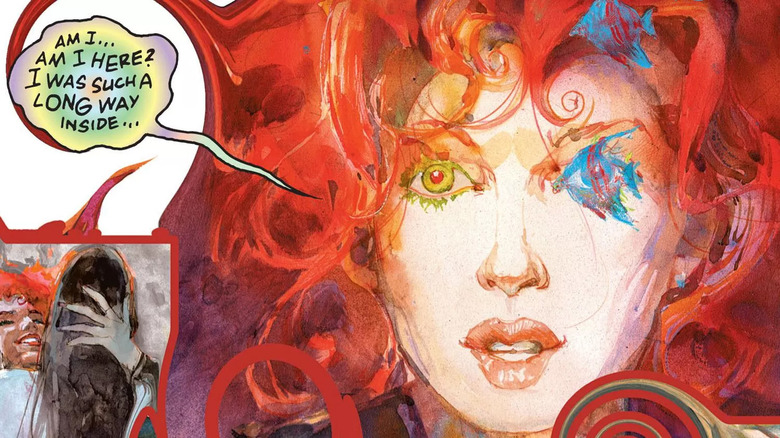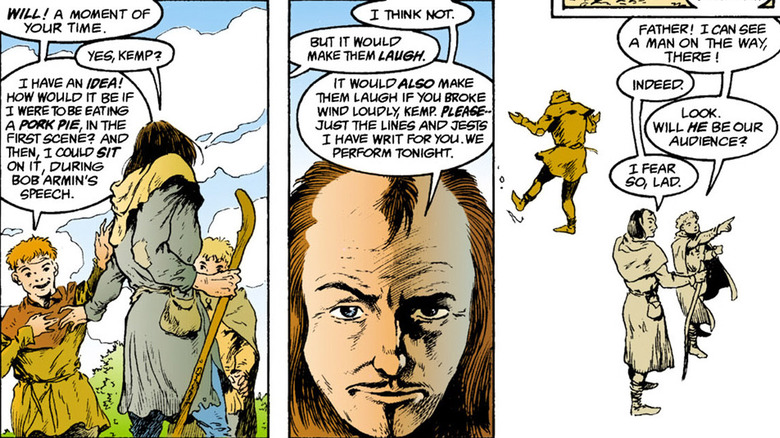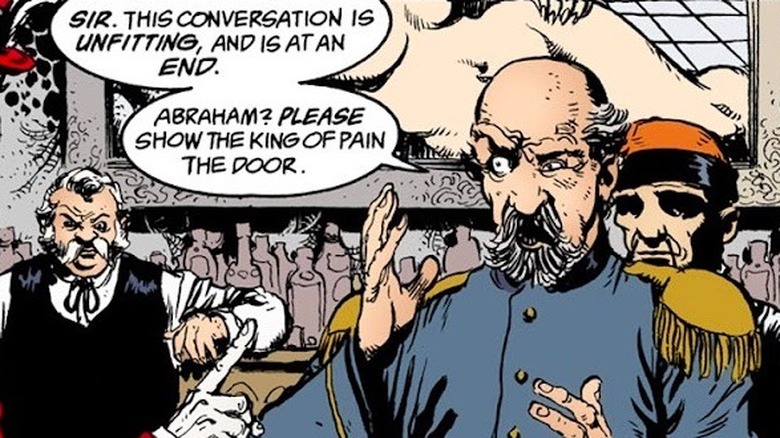Characters We Want To See In The Sandman Season 2
Netflix's "The Sandman" has garnered acclaim from critics, comic readers, and fans who are entirely new to Neil Gaiman's imaginative universe. A faithful take on the beloved comic series of the same name, the show follows Dream, aka Morpheus (Tom Sturridge) of the Endless, after he escapes from a lengthy imprisonment. In his attempts to rebuild his derelict kingdom, he confronts many friends, family members, and enemies. The world has changed — can an eternal avatar of imagination itself change with it?
There is plenty to love about "The Sandman." But one element is especially key to the show's success: Its diverse cast of characters. Viewers meet several fan-favorite figures in Season 1, like Dream's upbeat sister Death (Kirby Howell-Baptiste), the nightmarish Corinthian (Boyd Holbrook), and sarcastic janitorial pumpkin-head Mervyn (Mark Hamill). As they look to Season 2, fans can't help but wonder which fantastic figures from the comic will appear in future installments. From Dream's fellow members of the Endless to several important historical figures, these are the characters we hope to see in "The Sandman" Season 2.
Destiny
The eldest of the Endless, Destiny has roots that are actually older than "The Sandman." Created by comic book legends Marv Wolfman and Bernie Wrightson, Destiny first appeared in 1972's "Weird Mystery Tales" #1. True to his original interpretation, Destiny of "The Sandman" is an enigmatic figure shrouded in a cloak. Though he's blind, Destiny sees the entirety of the past, present, and future within the Book of Destiny that is chained to his person. Morose, foreboding, and unemotional, even compared to his brother Dream, Destiny periodically appears in "The Sandman" to deliver profound warnings to his siblings, which usually clue them into some problem they'll have to deal with in the near future.
Arguably the member of the Endless who takes his duties most seriously, Destiny never abuses his power for personal gain or tampers in the mortal realm. Like some of his siblings, he can be very blunt and dry. But he's anything but boring — his simple design alone is enough to capture readers' attention. Given his relative lack of appearances compared to the rest of the Endless, it'd be interesting to see Destiny explored in future seasons of "The Sandman," perhaps even in ways the comic doesn't dare. But even if the writers stay true to the comic's vision, it'd still be fascinating to see Destiny deliver grim tidings to Dream.
Destruction
Dubbed "the Prodigal" by his siblings, Destruction is Dream's younger brother. After reigning as the incarnation of destruction since the dawn of creation, Destruction chooses to leave his duties behind in the early 18th century. This is spurred by the Age of Reason, and his attendant realization that humankind will use science for destructive purposes. His departure causes a major rift within his family.
His role vacated, Destruction chooses to pursue his artistic passions and live a life of carefree adventure. Wandering Earth for the next few centuries with only his canine companion Barnabas by his side, Destruction manages to break off all ties with his family, making it nearly impossible for them to find him. But no one can stay missing forever, and soon, the Endless catch up with him.
Despite his sinister-sounding moniker, Destruction is a warm and energetic character. His unsuccessful attempts to pursue his creative interests are enough to make anyone laugh, and would translate very well to the Netflix series. As his central storyline is explored in a later arc of "The Sandman," it's unlikely we'll see him play a large part in Season 2. But some minor scenes teasing an appearance would be enough to satisfy most comic fans.
Delirium
The youngest of the Endless, Delirium was actually the personification of Delight many centuries prior to the events of "The Sandman." At some point, a traumatic event transformed her into Delirium, but readers never learn the details. Appearing as a redheaded young woman, Delirium is absent-minded, fantasy-prone, and equally capable of whimsy and melancholia. She occupies a fairly neutral role in the story, rarely antagonizing Morpheus or any of her other siblings.
Hopefully, Delirium's appearance on "The Sandman" will come sooner rather than later — she's one of the comic's most beloved characters. Between her dreaminess, childlike curiosity, and playful behavior, she'll make a hilarious foil to Tom Sturridge's moody Dream. Notably, Delirium's physical features are in constant flux, reflecting her chaotic mindset. This might prove to be a challenge for the show to pull off, but pulling it off successfully could prove to be one of the show's greatest successes.
Bast
Morpheus interacts with many different religious and mythological figures over the course of "The Sandman." Among the more notable deities is Bast, an ancient Egyptian goddess whose power has slowly diminished as the years have gone on. When she first appears in the comic, she's a shadow of her former self, accompanying her fellow Egyptian gods to ask Morpheus' for the key to Hell.
Bast is by far one of the most interesting characters to interact with Dream. Openly flirtatious in her manner towards the Lord of the Dreaming, she's one of the few deities who doesn't harbor some sort of secretive motivation — in fact, she's something of an ally to Dream. Dream reciprocates Bast's warm regard, speaking openly and plainly to her and even asking her for advice in moments of inner conflict. Bringing her to the Netflix adaptation would offer viewers greater insight into Dream's mind and humanize him a bit more.
The Presence
A being known as the Presence oversees DC's expansive comic book universe. This entity wields limitless power, and is responsible for creating all life in existence. Essentially, he's the Abrahamic God, source of all life and knowledge — and yet, in the world of "The Sandman," he's also the result of humanity's dreams. Whatever his origins, he's extraordinarily powerful, and directly speaks to many of DC's more supernatural characters. In "The Sandman," the Presence rules the angelic metropolis known as the Silver City and presides over a host of Biblical angels sworn to carry out his doings.
The Presence would be a welcome addition to Netflix's "The Sandman." Admittedly, the character doesn't appear all that often in the original comic; he's a lot more prominent in the spin-off series "Lucifer." However, having him appear to Morpheus in some capacity, no matter how small, might make for some very interesting exchanges. The show could even touch upon the driving premise behind "Lucifer," which sees the Presence run away from his duties, leaving a power vacuum in the Silver City that numerous angels try to fill.
Time
Father of the Endless, Time is one of the oldest beings in the universe. He's notably absent from the original run of "The Sandman," making his first appearance in the 2013 prologue, "The Sandman: Overture." In that story, Dream appears before Time to request his help in stopping the universe from ending. Tired of his children always asking for favors, Time refuses, casting Dream out and leaving the universe to its fate.
Time's appearance in "The Sandman: Overture" is one of the series' standout moments. As the personification of time itself, he occupies a realm of constant change, allowing him to simultaneously appear as a child, adult, and wizened old man. This is spectacularly portrayed by artist J. H. Williams III, whose fluid visuals are an absolute wonder. Seeing Time presented in Netflix's take on the story could make for a visually astounding scene, likely necessitating several actors.
William Shakespeare
"The Sandman" is well known for having both historical and fictional characters appear within its pages, from notorious figures like Maximilien Robespierre to iconic comic book villains like the Scarecrow. Belonging to the former category is William Shakespeare, the legendary Elizabethan playwright who appears in several high-profile issues. He's most famously featured in "The Sandman" #19, "A Midsummer Night's Dream," which netted Neil Gaiman and artist Charles Vess a World Fantasy Award.
In the context of "The Sandman," Shakespeare is a human affected by immortal forces. The Bard of Avon strikes a deal with Dream: The latter will feed him inspiration in exchange for two plays, "A Midsummer Night's Dream" and "The Tempest." Shakespeare also stars in the very last issue of the series, "The Sandman" #75, which provides an epilogue to Dream's story and concludes the lengthy bargain struck between the playwright and the Lord of the Dreaming.
Shakespeare is one of the most frequently featured historical figures within "The Sandman." His interactions with Dream bring depth and texture to the tale, which would translate wonderfully to the Netflix series. As sharp-eyed fans will have noticed, he's already made his debut in the show: He pops up in Episode 6, "The Sound of Her Wings." Expanding his role would be simple and very much worth the effort.
Orpheus
A figure from Greek mythology, Orpheus is the son of Dream and the muse Calliope. As in the classic myth, Orpheus' wife, Eurydice, dies not long after their wedding. Distraught, Orpheus descends into the underworld, confronts Hades, and strikes a bargain: If Orpheus can walk back to the mortal world without ever turning around to make sure Eurydice is there, she will be restored to life. But as they near the surface, Orpheus does indeed look back, casting Eurydice back into death. Later, a devastated Orpheus is dismembered by the frenzied maenads, followers of Dionysius. But because of his immortality, he survives as a disembodied head. For the next several thousand years, Orpheus' head endures — as does the rift between him and his father.
As is the case with Calliope, Orpheus' presence in Netflix's adaptation of "The Sandman" could allow for a deeper understanding of Morpheus' failures. Orpheus' relationship with his father is also climactic — it's basically the lynchpin of the final act of the series. Seeing that troubled bond explored in the live-action adaptation would help humanize Morpheus' character and spur the action to even greater heights.
John Constantine
John Constantine, everybody's favorite chain-smoking, trench coat-clad street magician, is a beloved DC Comics character. He appears early on in "The Sandman," as he comes into possession of Morpheus' magical sand while the Lord of the Dreaming is imprisoned by Roderick Burgess.
As fans know, a version of Constantine does appear in Netflix's "The Sandman": Johanna Constantine (Jenna Coleman), an occult expert whose adventure in Episode 2, "Imperfect Hosts," largely mirrors John Constantine's introduction in the comic series. Johanna is great, but it would still be incredibly interesting to see the original Constantine appear alongside her. Just imagine how much fun a conversation between the two Constantines could be.
Perhaps Netflix could even manage to introduce pre-existing live-action iterations of the character. Keanu Reeves' interpretation of the sorcerer in 2005's "Constantine" would be immensely fun to see on the series, as would Matt Ryan's version of the character from the 2014 "Constantine" TV series. It may seem like quite a jump to bring these Constantines into the mix, but there's no doubt they'd be exciting additions to the universe of the Netflix adaptation. Their appearances could even open the door to cameos from other DC projects. For example, Ryan's Constantine pops up on "Arrow" and "Legends of Tomorrow." Imagine seeing Morpheus interact with characters like Black Canary, Hawkgirl, and Mister Terrific. It might seem like a long shot, but stranger things have happened on "The Sandman" already — why not dream big?
Wesley Dodds
You might not recognize the name Wesley Dodds, but you will recognize his superheroic moniker: He's the first DC character to carry the mantle of the Sandman. A character who dates all the way back to 1939, Dodds figures into the original "Sandman" comic series in an interesting way. He appears in the very first issue as a 1930s businessman who temporarily succeeds Morpheus when he's imprisoned by Roderick Burgess. Donning a long trench coat, a green suit, a fedora, and a World War I-era gasmask, Dodds takes to the streets, using his signature "gas gun" to knock out enemies and combat villainy wherever it sprouts.
Later on, this version of Dodds received his own successful spin-off series in Matt Wagner and Guy Davis' excellent "Sandman Mystery Theatre." This comic follows Dodds' crusade against crime in 1930s New York City. Morpheus appears to Dodds in a limited capacity over the course of the series, usually by dropping into Dodds' restless dreams. This isn't exactly comforting: Dodds becomes so terrified of Morpheus' repeated appearances that he takes to wearing his trademark gas mask, which is itself modeled after Morpheus's own Helmet of Dreams.
Dodds' historical milieu and classically noir wardrobe might make him seem a bit out of step with "The Sandman." But the series has already jumped back and forth in time — if Hob Gadling can work, why not Wesley Dodds? An appearance from the original DC Sandman could be immensely fun, much like the show's inclusion of the second canonical Sandman, Daniel Hall.
Urania Blackwell
One of Neil Gaiman's main talents as a writer has always been his ability to take outdated superhero characters and turn them into realistic, nuanced individuals. Take Urania Blackwell, a little-known DC hero who debuted in 1967's "Metamorpho" #10 under the name Element Girl. Once a spy for the U.S. government, Blackwell's colleague, Rex Mason, was exposed to the Orb of Amun-Ra while on assignment in Egypt. This transformed him into the superhero Metamorpho. After duplicating his mystical transformation, Blackwell became his partner.
Sadly, gaining the superhuman ability to turn into any element isn't all it's cracked up to be. By the time she appears in "The Sandman" #20, a despondent Blackwell has retreated into complete isolation. Insecure about her bizarre physical appearance, she spends her days locked away in her apartment, chain-smoking in the shadows. After a disastrous outing with an old friend, Blackwell begs Death to end her life. Moved, Death convinces Blackwell to ask Ra for help. The sun god ends her immortality at last, allowing her to pass onto the next plane of existence.
Element Girl's story is easily one of the most heartbreaking tales in "The Sandman." It's impossible not to empathize with Blackwell, whose experiences with superheroism have gone so poorly. She also offers a unique window into the Egyptian pantheon, who are otherwise represented by Bast within the series. Ra doesn't exactly come off well here, having condemned Blackwell to an extremely lonely life, but he's certainly interesting.
If you or anyone you know is having suicidal thoughts, please call the National Suicide Prevention Lifeline by dialing 988 or by calling 1-800-273-TALK (8255).
Emperor Norton I
Many historical figures are presented in some way, shape, or form within the pages of "The Sandman," but few are more interesting than Joshua Norton. A widely beloved eccentric who lived during the 19th century, Norton was a San Francisco resident who declared himself Norton I, Emperor of the United States, in 1859. Until his death over 20 years later, Norton presented himself as the undisputed ruler of his nation, and eventually, the "Protector of Mexico" as well. Despite lacking any official political power, his fame spread throughout the city, leading him to become one of San Francisco's most famous citizens.
Norton stars in "The Sandman" #31, which spins a memorable yarn entitled "Three Septembers and a January." Norton is initially portrayed as a wealthy businessman who's been laid low by several calamitous ventures. Finding him in her domain, Despair challenges Morpheus to find a way to give Norton's life meaning through his dreams. Morpheus reluctantly accepts this challenge. From that point on, Norton lives a happy life, believing he's an imperial monarch. His dreams are so powerful, he's able to withstand temptations from Despair, Desire, and Delirium. His sanity might not look like others', but it is sanity nonetheless.
Norton is likable, sympathetic, and engaging as a protagonist. His basis in reality makes him an even more interesting character. These central facts make "Three Septembers and a January" a stand-out story that could easily make the jump to the small screen. Norton would be right at home beside the TV series' charming weirdos, and his story could do wonders to illuminate the tensions between Dream, Desire, and Despair.












